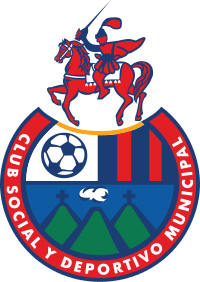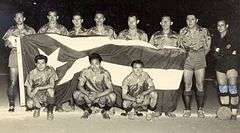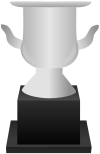C.S.D. Municipal
 | |||
| Full name | Club Social y Deportivo Municipal | ||
|---|---|---|---|
| Nickname(s) |
Rojos (Reds) El Mimado de la Aficion (Fans' Pampered Team) Diablos Rojos (Red Devils) | ||
| Founded | May 17, 1936 | ||
| Ground | Estadio Manuel Felipe Carrera | ||
| Capacity | 7,500 | ||
| Chairman | Gerardo Villa | ||
| Manager | Mauricio Wright | ||
| League | Liga Nacional de Fútbol | ||
| 2015 Clausura | Runners up | ||
|
| |||
Club Social y Deportivo Municipal, also known as Municipal or Los Rojos (the Reds), is a Guatemalan football club based in Guatemala City.
They compete in the Liga Nacional, the top division in the nation, and play their home matches at the Estadio Mateo Flores. As of 2015, they are the team that has remained the most years at the top level in Guatemala, having done so since the inception of the national league in 1942. They have won the domestic league 29 times; their most recent title came in the 2011 Apertura tournament. They won the CONCACAF Champions' Cup in 1974.
Municipal is the most popular football club in Guatemala and are traditional arch-rivals of club Comunicaciones, who is also located in Guatemala City.
History
The club was founded on May 17, 1936 by workers of the Ayuntamiento (city hall) of the Guatemala City municipality, hence the name Municipal, earning promotion to the maximum division (then called Liga Capitalina) in 1938. They finished in second place in their debut season,[1] and have since remained in the top division.
Early domestic success (1940s–1960s)
The team won its first national league title in the 1942–43 tournament, the first ever official national league championship in Guatemala. They won three of the following six tournaments, the other three being won by Tipografía Nacional, whom which they had their first known rivalry. Municipal were coached by Manuel Felipe Carrera, one of the original founders of the club, and whose name was later given to the stadium where the team currently practices.
During the 1940s and early 1950s, Municipal's most emblematic player was the forward Carlos "Pepino" Toledo, who wore the red shirt throughout his career. He helped the club win their first four league titles, the last of them coming at the 1954–55 tournament, which was Toledo's last year of play. He scored 129 career goals, a total which remains the fourth-highest in the history of the club, and was also one of the first nationwide-recognized players, becoming a member of the national team. Later, he became Municipal's coach.

In 1948, Municipal won a friendly tournament in Havana, Cuba that was celebrated as part of the commemoration acts of the Cuban Independence. Toledo, Mario Camposeco, and goalkeeper José Pedro "Tarzán" Segura were members of that squad.[2]
At the end of the 1950s, as Comunicaciones emerged as one of the top contenders in the league – winning it three years in a row –, Municipal went 8 straight years without winning a championship, but then won three of them in the 1963–64, 1965–66, and 1969–70 seasons. These titles alternated with three titles won by Aurora – another club from the city – and coincided with a decline for Comunicaciones in that decade. When Tipografía Nacional faded as one of the top clubs of the nation, a fierce rivalry originated between Municipal and Comunicaciones, especially after the latter became the country's second most successful club, having won 7 of 14 league tournaments from 1956 to 1972. Both teams have been classic rivals ever since, with the matches between them usually attracting the most spectators of any local club football event.
1970s: First international success
Starting in 1973, Municipal obtained a series of titles under Uruguayan coach Rubén Amorín, who took the team to league titles in successive years for their first time ever. Amorín managed a group of players that included defender Alberto López Oliva, midfielders Benjamín Monterroso and José Emilio "Pepe" Mitrovich, and forward Julio César Anderson (who would become the highest goalscorer ever for the club, until surpassed in the 2000s by Juan Carlos Plata), to their first international title, winning the 1974 Copa Fraternidad. However, Municipal's greatest achievement occurred in that same year, when they won the IV CONCACAF Champions' Cup, becoming the first – and only to date – Guatemalan team to have won the confederation's top club competition. The Rojos then went on to play the Copa Interamericana against Argentina's "red team", Independiente, on a two-leg playoff celebrated at the Estadio Mateo Flores in Guatemala. The first leg, played November 24, 1974, was won by Independiente de Avellaneda 1–0, on a goal by Ricardo Bochini. Two days later, Municipal, in need of a win, beat the Argentines 1–0, thanks to a goal by the Argentine-born José Emilio "Pepe" Mitrovich in the second half. With both teams equal in points and goal difference, the match went to extra time, where there was no change in the score. The winner of the continental title was then decided on penalty kicks. After misses by Julio César "Morocho" Anderson and Benjamín "Mincho" Monterroso, Independiente de Avellaneda won the shootout 4–2, and ended Municipal's international run.
1980s: Almost relegated
After winning another league title in 1976 and the 1977 Copa Fraternidad, the club faced their worst period, unable to win any titles and even being close to dropping from the top division, playing a relegation mini-tournament in the 1981 season – which saw Tipografía Nacional go down to the Division B. In 1982, Municipal struggled again, this time finishing ahead of the relegated team on goal differential.
1990s: Return to the top
Success came again in 1987, with the first league title in 11 years, won under Argentine coach Miguel Ángel Brindisi. This time, the team won three consecutive championships for the first time ever, the first two being coached by Brindisi, and the third one by Walter Ormeño. In the 1991–92 season, almost two decades after his last title with the club, Rubén Amorín, on his second tenure, took Municipal to another league title.
Municipal were close to repeating the CONCACAF success of 1974 when the Champion's Cup finals were played in the Mateo Flores in Guatemala City in December 1993. The team faced Mexican club León, Saprissa of Costa Rica and Robinhood of Suriname in a single round-robin tournament. High expectations preceded those matches, as Municipal was in good form in the local tournament, unbeaten and at the top of the table; however, the team fell short of the title as all three matches between Municipal, Saprissa and León ended in draws, and Saprissa, who played against the weak Robinhood in the last matchday, beat the Surinamese team 9–0 and won the title on goal differential. Still, a fifth league championship in seven years came at the end of the 1993–94 season, under Argentine coach Horacio Cordero.
2000s: A Decade of Success
In 2000, after the league's competition format was changed to two yearly tournaments on the Apertura and Clausura fashion, Municipal won the title again after Comunicaciones had set a record by winning the previous four; Municipal surpassed that record in 2006 when they won the 2006 Apertura tournament, their fifth consecutive title, under coach Enzo Trossero. They also added third and fourth Central American titles by winning the Copa Interclubes UNCAF in 2001 and 2004.
Colours and crest
Initially, the team's uniform colors consisted of a red-and-black striped shirt and black shorts.[3] The colours soon changed to the current red shirt and blue shorts for home matches, and all blue for away matches, although other colors have been used for away matches.
The club's logo is based in the emblem of the Municipalidad de Guatemala, which is itself based in the original coat of arms of the city of Santiago de los Caballeros de Guatemala, with the image of Apostle Santiago (Saint James) over the stylized scenery of the region. The team's version includes an image of the type of ball used at the time the club was founded, next to a blue and red striped canton in between the former two elements. The circular field is surrounded by the name of the team on a red background.
Stadium
Throughout the years, Municipal has used the Estadio Mateo Flores as their home ground, sharing it with Comunicaciones since the 1950s until 1991, and again starting in 2005. Other stadiums hosted Municipal in the beginning, namely the Estadio Autonomía. The Estadio La Pedrera has been used when the Mateo Flores has not been available. The Estadio Manuel Felipe Carrera, also known as "Estadio El Trébol", has been the training venue for the team, and it has been occasionally used for official matches by the club; Municipal had an undefeated streak of 33 official matches in this ground from July 9, 1991 until March 7, 2008, when they lost to Deportivo Petapa 1–0 for the 2008 Clausura tournament.[4]
Supporters
Municipal is believed to have the largest fan base of all Guatemalan clubs, and that their popularity have earned them nicknames like El mimado de la afición (Fans' pampered team) and El equipo del pueblo (People's team).
Statistics and records
Municipal has set a record in Guatemalan football by being the club that has spent the most consecutive seasons in the maximum division, having remained there uninterruptedly since 1938.
Juan Carlos Plata is the team's all-time top goalscorer in league matches and overall. As of the end of 2010, Plata has scored 299 league goals and 403 overall goals with Municipal,[5] the only club he has played for.
Honours
- 1942–43, 1947, 1950–51, 1954–55, 1963–64, 1965–66, 1969–70, 1973, 1974, 1976, 1987, 1988–89, 1989–90, 1991–92, 1993–94, 2000 Clausura, 2000 Apertura, 2001 Apertura, 2002 Clausura, 2003 Apertura, 2004 Apertura, 2005 Clausura, 2005 Apertura, 2006 Clausura, 2006 Apertura, 2008 Clausura, 2009 Apertura, 2010 Clausura, 2011 Apertura
- 1960, 1967, 1969, 1994–95, 1995–96, 1998–99, 2003, 2003–04
- Campeón de Campeones (Super Cup): 5
- 1952, 1967, 1977, 1994, 1996[6]
- 1974
- 1974, 1977, 2001, 2004
- Runners-up – 1974
Players
Current squad
- As of 2015
Note: Flags indicate national team as defined under FIFA eligibility rules. Players may hold more than one non-FIFA nationality.
|
|
Squad Changes for the Apertura 2015
In:
Out:
Retired numbers
15 – ![]() Juan Carlos Plata, forward (1990–10)
Juan Carlos Plata, forward (1990–10)
Notable players
Players with at least two years of service for the club are listed here.
Former[7]
|
|
Active
|
|
Coaches
Champion coaches
|
List of coaches
|
|
References and notes
- ↑ "Guatemala, 100 años de fútbol – Municipal". Prensa Libre (in Spanish). Archived from the original on 2006-12-09. Retrieved 2006-12-10.
- ↑ La Habana, Cuba 1948 Archived April 25, 2012, at the Wayback Machine.
- ↑ "Historia, Rojos del Municipal" (in Spanish). Retrieved 2006-12-10. – Note: Unable to retrieve direct link. Click on "Historia" on the main menu to access.
- ↑ "Rojos pierden el invicto en El Trébol". Prensa Libre (in Spanish). Archived from the original on 2008-03-13. Retrieved 2008-03-20.
- ↑ Source: http://www.rojos.com/~csdm/aficionados/plata/index.htm
- ↑ RSSSF (2009). "Guatemala – List of Cup Winners". Retrieved 10 December 2010.
- ↑ Player years, except for Carlos Toledo's and Juan Manuel Funes', are taken from (Spanish) http://www.angelfire.com/ms/rojosoasis/page5.html
Further reading
- "Guatemala, 100 años de fútbol – Municipal". Prensa Libre. Archived from the original on 2006-12-09. Retrieved 2006-12-10.
External links
| Wikimedia Commons has media related to C.S.D. Municipal. |
- (Spanish) Official web site
- (Spanish) Official fan site
- (Spanish) Press fan site
